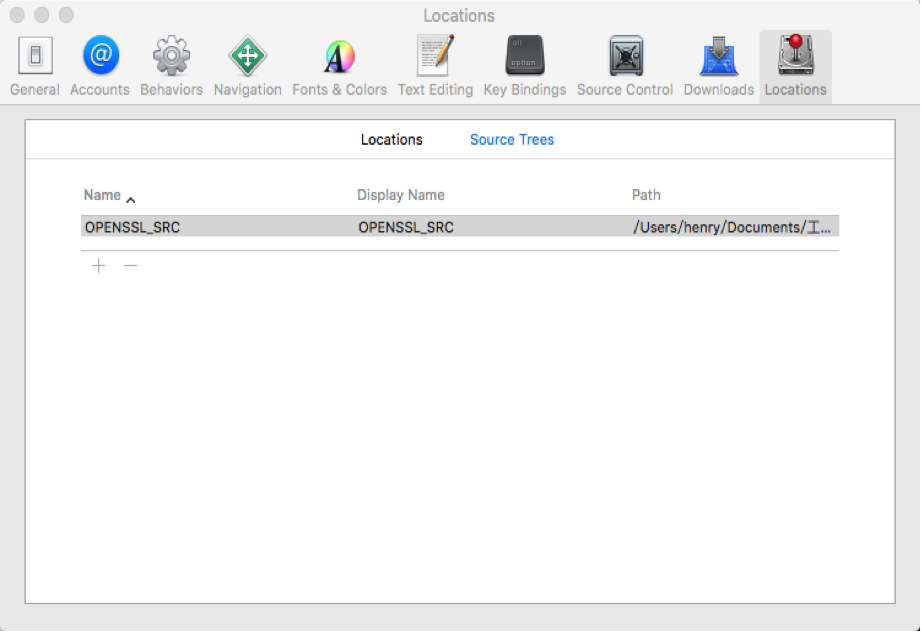cd ~/Documents/code/SQLCipherApp git clone https://github.com/sqlcipher/openssl-xcode.git
下载 sqlcipher
cd ~/Documents/code/SQLCipherApp git clone https://github.com/sqlcipher/sqlcipher.git
下载 openssl-1.0.0e
curl -o openssl-1.0.0e.tar.gz http://www.openssl.org/source/openssl-1.0.0e.tar.gz //解压 tar xzf openssl-1.0.0e.tar.gz
把这三个目录拷贝到工程目录中
1、打开Xcode 的设置页,进入locations ->source trees ,点击+号添加项目 ,settingname 和 display name 均设为 “OPENSSL_SRC” path设置为你工程目录下openssl-1.0.0e的所在路径。比如我的路径是:/Users/henry/Documents/工程公用/SQLCipherApp/openssl-1.0.0e



//打开数据库的函数 +(BOOL) OpenDB { NSArray *pathArr = NSSearchPathForDirectoriesInDomains(NSDocumentDirectory, NSUserDomainMask, YES); NSString *docPaths = [pathArr objectAtIndex:0]; NSString *dbPath = [docPaths stringByAppendingFormat:@"/myDB.db"]; int status = sqlite3_open([dbPath UTF8String], &GB_DB); if (status != SQLITE_OK) { LOG_CINFO(@"打开数据库出错!"); DB_Opened = NO; return DB_Opened; } DB_Opened = YES; sqlite3_stmt *statement; #if UseASE //验证sql语句是否成功 const char *key = [[GlobalData GetInstance].GB_DBKey UTF8String]; sqlite3_key(GB_DB, key, strlen(key)); #endif if(sqlite3_prepare_v2(GB_DB, [sql UTF8String], -1, &statement, nil) != SQLITE_OK) { LOG_CINFO(@"创建表格失败!"); return NO; } int success = sqlite3_step(statement); sqlite3_finalize(statement); //[MyDataBase CloseDB]; if (success != SQLITE_DONE) { LOG_CINFO(@"在创建表格的过程中出错,创建没有进行完!"); return NO; } return YES; }
//创建需要的数据表
+ (void)CreateNeedTable {
@autoreleasepool {
//插入用户信息表
LocalDataBase *userTb = [LocalDataBase GetTableWithType:@"user" HasUser:NO];
//先创建
[userTb CreateTableWithKeys:[NSArray arrayWithObjects:@"userid", nil] OtherNeeds:[NSArray arrayWithObjects:@"siteid",@"username",@"password",@"mobilePhone",@"name", nil] Data:nil];
}
//根据参数创建表,keys是主键,needs是那些非主键,但是必须需要的,如需要用它来排序,搜索的字段,data为数据项的整个data形式,用data是为了减少字段数
-(BOOL) CreateTableWithKeys:(NSArray *)keys OtherNeeds:(NSArray *)needs Data:(NSString *)data {
//如果有信息,说明注册成功了已经
if(self.myTableInfo)
{
return YES;
}
//首先确保数据库是打开的
if (![LocalDataBase OpenDB])
{
return NO;
}
//把所有非数据的字段写到一个数组中
NSMutableArray *allArr = [NSMutableArray arrayWithCapacity:10];
if ([keys count] > 0)
{
[allArr addObjectsFromArray:keys];
}
if ([needs count] > 0)
{
[allArr addObjectsFromArray:needs];
}
if (self.hasUser)
{
[allArr insertObject:@"userName" atIndex:0];
}
int keysCount = [allArr count];
if (self.myTableInfo == nil)
{
self.myTableInfo = [NSMutableArray arrayWithCapacity:keysCount+1];
}
//插入数据
for(int i = 0; i < keysCount;++i)
{
NSString *key = [allArr objectAtIndex:i];
[self.myTableInfo addObject:[NSDictionary dictionaryWithObjectsAndKeys:@"text",@"type", key,@"key", nil]];
}
//创建sql语句
NSMutableString *cSql = [NSMutableString stringWithFormat:@"create table if not exists %@ (",self.myTableName];
//把非数据类型的字段加入sql语句
for(NSString *key in allArr)
{
[cSql appendFormat:@"%@ text,",key];
}
//把数据类型的字段加入Sql语句
if (data != nil)
{
[cSql appendFormat:@"%@ blob,",data];
[self.myTableInfo addObject:[NSDictionary dictionaryWithObjectsAndKeys:@"blob",@"type", data,@"key", nil]];
}
//添加主键
[cSql appendString:@"primary key("];
int keyCount = [keys count];
if (keyCount > 0)//有多个主键的情况
{
for(int i = 0; i < keyCount - 1; ++i)
{
NSString *key = [keys objectAtIndex:i];
[cSql appendFormat:@"%@,",key];
}
if(self.hasUser)
{
[cSql appendString:@"userName,"];
}
[cSql appendFormat:@"%@)",[keys objectAtIndex:keyCount - 1]];
}
else
{
// if (keyCount == 1)//只有一个主键的情况
// {
// [cSql appendFormat:@"%@)",[keys objectAtIndex:0]];
// }
// else
{
if(self.hasUser)
{
[cSql appendString:@"userName)"];
}
}
}
[cSql appendString:@")"];
LOG_CINFO(@"========sql 语句 创建表=========");
LOG_CINFO(cSql);
{
NSMutableDictionary *dic = (NSMutableDictionary *)[GlobalFunc ParseDicFromFile:@"dbInfo.plist"];
if (dic == nil)
{
dic = [NSMutableDictionary dictionaryWithCapacity:1];
}
[dic setObject:self.myTableInfo forKey:self.myTableName];
[GlobalFunc WriteDicToFile:dic FileName:@"dbInfo.plist"];
}
return [LocalDataBase CreateTableWithSql:cSql];
}
//向表中插入数据
-(BOOL) InsertDataWithDic:(NSDictionary *)dic Replace:(BOOL) replace {
// 打开数据库
if (!DB_Opened)
{
if(![LocalDataBase OpenDB])
{
LOG_CINFO(@"插入数据失败,打开数据库出错!");
return NO;
}
}
NSMutableDictionary *tmpDic = [NSMutableDictionary dictionaryWithDictionary:dic];
if (self.hasUser)
{
[tmpDic setObject:[GlobalData GetInstance].GB_UserName forKey:@"userName"];
}
NSMutableArray *allKeys = [NSMutableArray arrayWithArray:[tmpDic allKeys]];
NSMutableString *cSql = nil;
//生成插入语句
if (replace)
{
cSql = [NSMutableString stringWithFormat:@"insert or REPLACE into %@(",self.myTableName];
}
else
{
cSql = [NSMutableString stringWithFormat:@"insert into %@(",self.myTableName];
}
int keysCount = [allKeys count];
if (keysCount > 0)
{
for(int i = 0; i < keysCount-1;++i)
{
[cSql appendFormat:@"%@,",[allKeys objectAtIndex:i]];
}
[cSql appendFormat:@"%@)",[allKeys objectAtIndex:keysCount -1]];
}
else
{
return NO;
}
[cSql appendString:@" values("];
for(int i = 0; i<keysCount -1; ++i)
{
[cSql appendString:@"?,"];
}
[cSql appendString:@"?)"];
LOG_CINFO(@"========sql 语句 插入表=========");
LOG_CINFO(cSql);
//测试sql 语句是否正确
sqlite3_stmt *statement;
const char *insertStatement = [cSql UTF8String];
#if UseASE
//验证sql语句是否成功
const char *key = [[GlobalData GetInstance].GB_DBKey UTF8String];
sqlite3_key(GB_DB, key, strlen(key));
#endif
if(sqlite3_prepare_v2(GB_DB, insertStatement, -1, &statement, NULL) != SQLITE_OK)
{
LOG_CINFO(@"向表格中插入数据失败,可能Sql语句不正确!");
[GlobalFunc ShowNormalAlert:[NSString stringWithFormat:@"向表格中插入数据失败,可能Sql语句不正确,表名为%@",self.myTableName]];
return NO;
}
for(int i = 0; i < keysCount;++i)
{
NSString *key = [allKeys objectAtIndex:i];
id value = [tmpDic objectForKey:key];
//如果是Data类型
if ([value isKindOfClass:[NSData class]])
{
sqlite3_bind_blob(statement, i+1, [value bytes], [value length], NULL);
}
else//是字符串类型
{
sqlite3_bind_text(statement, i+1, [value UTF8String], -1, NULL);
}
}
int success = sqlite3_step(statement);
// 释放资源
sqlite3_finalize(statement);
if (success == SQLITE_ERROR)
{
LOG_CINFO(@"向表格中插入数据失败,未知原因提前结束!");
[GlobalFunc ShowNormalAlert:[NSString stringWithFormat:@"向表格中插入数据失败,未知原因提前结束,表名为%@",self.myTableName]];
return NO;
}
LOG_CINFO(@"向表格中插入数据成功!");
return YES;
}
//更新表字段,key是要更新的字段名称,newValue是更新后要设计的值,where是条件(sql语句中的),condition是满足更新的条件,use是否使用用户名为条件
-(BOOL) UpdateRecordWithKey:(NSString *)key Value:(NSString *)newValue Where:(NSString *)where Condition:(NSString *)condition UseUser:(BOOL)use {
if(![LocalDataBase OpenDB])
{
return NO;
}
@try
{
NSString *tmpUpdateSql = nil;
if (use && self.hasUser)
{
tmpUpdateSql = [NSString stringWithFormat:@"UPDATE %@ SET %@ = ? where %@ = ? and userName = ?",self.myTableName,key,where];
}
else
{
tmpUpdateSql = [NSString stringWithFormat:@"UPDATE %@ SET %@ = ? where %@ = ?",self.myTableName,key,where];//@"UPDATE tb_bulletlist SET has_read = ? where bulletin_code = ? and user_name=?";
}
sqlite3_stmt *statement;
LOG_CINFO(@"========sql 语句 更新表=========");
LOG_CINFO(tmpUpdateSql);
#if UseASE
//验证sql语句是否成功
const char *key = [[GlobalData GetInstance].GB_DBKey UTF8String];
sqlite3_key(GB_DB, key, strlen(key));
#endif
if(sqlite3_prepare_v2(GB_DB, [tmpUpdateSql UTF8String], -1, &statement, nil) != SQLITE_OK)
{
LOG_CINFO(@"更新数据失败!");
[GlobalFunc ShowNormalAlert:[NSString stringWithFormat:@"更新数据失败,表名为%@",self.myTableName]];
return NO;
}
sqlite3_bind_text(statement, 1, [newValue UTF8String], -1, NULL);
sqlite3_bind_text(statement, 2, [condition UTF8String], -1, NULL);
if (use && self.hasUser)
{
sqlite3_bind_text(statement, 3, [[GlobalData GetInstance].GB_UserName UTF8String], -1, NULL);
}
int success = sqlite3_step(statement);
sqlite3_finalize(statement);
//[MyDataBase CloseDB];
if (success != SQLITE_DONE)
{
LOG_CINFO(@"更新数据失败,未知原因提前结束!");
[GlobalFunc ShowNormalAlert:[NSString stringWithFormat:@"更新数据失败,未知原因提前结束,表名为%@",self.myTableName]];
return NO;
}
}
@catch (NSException *e)
{
// LOG_CERR(e);
}
return YES;
}
//根据传入的关键字和关键字的值,得到一条记录,如果不存在这条记录,返回为nil,估也可用来判断是否存在某条记录,use是否使用用户名为条件
-(NSMutableDictionary *) GetOneRecordWithKeys:(NSArray *)keys Values:(NSArray *)values UseUser:(BOOL)use {
if ([keys count] != [values count])
{
// [GlobalFunc ShowNormalAlert:[NSString stringWithFormat:@"GetOneRecordWithKeys 数据查询参数keys与values个数不一致,表名为%@",self.myTableName]];
return nil;
}
// 打开数据库
if (!DB_Opened)
{
if(![LocalDataBase OpenDB])
{
LOG_CINFO(@"查询数据失败,打开数据库出错!");
return nil;
}
}
NSMutableString *cSql = [NSMutableString stringWithFormat:@"select * from %@ where ",self.myTableName];
if (use && self.hasUser)
{
[cSql appendFormat:@"userName = '%@' and ",[GlobalData GetInstance].GB_UserName];
}
int keyCount = [keys count];
for (int i = 0; i < keyCount; ++i)
{
if (i == 0)
{
[cSql appendFormat:@"%@ = '%@'",[keys objectAtIndex:i],[values objectAtIndex:i]];
}
else
{
[cSql appendFormat:@" and %@ = '%@'",[keys objectAtIndex:i],[values objectAtIndex:i]];
}
}
NSArray *tmpArr = [self GetDataArrWithSql:cSql];
if ([tmpArr count] == 0)
{
return nil;
}
else
{
return [tmpArr objectAtIndex:0];
}
}
如果在编译时提示:No architectures to compile for (ARCHS=armv6,armv7, VALID_ARCHS=armv7 armv7s则将在Bulid Settings选项下面的Architectures和Valid Architectures里面都改成一样(例如:都填写 armv6 armv7),问题解决。 对于警告 :warning: implicit declaration of function 'sqlite3_key' is invalid in C99 只需要将Bulid Settings选项下的C Language Dialect 改为:C89[-std-c89] 就可以,即使用c89标准
或者去掉项目中的arm64
以上只是贴出代码的一部分,可能看起来有些吃力,稍后会把一个完整的使用数据库的类整理出来。
本文参考:http://blog.csdn.net/kuai0705/article/details/8931996





















 1513
1513











 被折叠的 条评论
为什么被折叠?
被折叠的 条评论
为什么被折叠?








